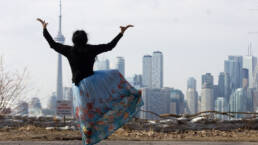
ChoreoSensing Public Spaces within Residential Neighbourhoods
August 18, 2023 | By Mushtari Afroz
The annual Ontario Culture Days’ Creatives in Residence series invites artists to develop community-engaged projects to be presented during the fall Festival. This year’s lineup of residents explore themes of material culture.
Mushtari Afroz is based in Pickering, Ontario. Her project involves a series of dance performances that will interact with Pickering’s public spaces and invite public participation.
Whether it’s urban or suburban areas in cities, public spaces in residential areas are fundamental to everyday life experiences which have been linked to the well-being and quality of life of residents. Consciously or unconsciously, we connect with them through multi-sensory interactions that help create overall impressions of our neighbourhood public spaces and establish meaningful connections with the neighbourhood community. In his book ‘The Eyes of Skin’, Finnish architect and author Juhani Pallasmaa reiterate this inseparable connection between human and their inhabited built environment by suggesting that ‘Our contact with the world takes place at the boundary line of self through specialized parts of our enveloping membrane.’ By specialized parts, Pallasmaa refers to our sensory organs which are in constant interaction with the surroundings and are constantly stimulated by it. In this complex physiological process of sensory stimulation what gets generated is our multi-sensory experience of the world. When our senses are stimulated in a positive way, we recall the memory or the perception of the place as some sort of good sensorial experience that encourages us to continue to engage with and inhabit that space.
However, the drive for creating ‘functional cities in the West through ‘disembodied’ practices has detached public spaces from our bodies, instituting the stage of mutual ‘disengagement’ as a retreat from everyday public spaces and deteriorating the sense of belonging to the residential neighbourhood environment. As a result, residents either tend to avoid connecting with public spaces or resemble an ‘auto-pilot’ state manifested through their lack of sensory attention to public spaces – they see the surroundings but do not look, they hear the surroundings but do not listen.
Recognizing the role that public spaces play in creating a sense of community, I ask my artist-self ‘How can sensory engagement with public spaces within residential areas be re-activated through artistic means in order to increase residents’ attachment to these spaces and (re)awaken their sense of belonging to their neighbourhoods?’ Since late 2021, I have been actively exploring this crucial question around residents’ lived experience of their neighbourhoods through various projects.
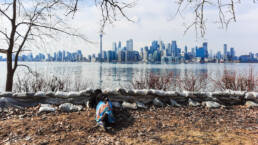
My first public space project ‘Drifting Dialogues’ was co-created with residents from Wards and Algonquin islands as well as with artists-in-residence at Artscape Gibraltar Point (AGP). As its Winter Island artist-in-residence 2022, I focused my research on the following questions – what is/are participants’ lived experience of the built environment on the island? Are there narratives in this interaction that often stay hidden from non-residents’ points of view? And how can I reflect on these narratives through embodied artistic expressions? The project culminated in a short documentary film and three short dance films that were presented at the Spring exhibition at AGP.
Trailer of the documentary ‘Drifting Dialogues’, Artscape Gibraltar Point. Film Credits: Dewan Masud Karim, Shawn Barry
My current ongoing public space project delves further into residents’ lived experiences by focusing particularly on their sensory connection with their public spaces. What has emerged from this deep dive is a new interdisciplinary artistic practice ‘ChoreoSensing’ that stands on the foundational pillars of four other practices-sensory practices, choreographic practice, participatory practice and tactical urbanism practice. This new practice enables residents to establish a deeper embodied and active sensory engagement – through visual and auditory receptors- with socio-physical dimensions of public spaces within their residential neighbourhoods.
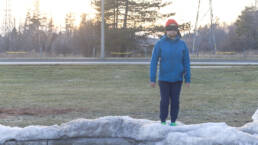
A. Sensory practice: As an artist-researcher, I develop this practice in neighbourhood public spaces to immerse myself in their visual and auditory dimensions. Two methods that are used in my practice to create this immersive experience are soundwalk and improvised movements. While the soundwalk attunes our hearing to the soundscape, improvised movements attune our sight and gaze to the multi-perspectival nature of the streetscape.
Visual perspective exploration of neighbourhood streetscape using GoPro Camera. Film Credit: Mushtari Afroz.
Choreographic Practice Development. Film Credit: Dewan Masud Karim.
B. Choreographic practice: Here I look at choreographic practice not as a method to create dance steps. Rather I look at it as an expanded method that lends its capacity to systematize movements in space and time for the production of human knowledge. Using choreographic thinking and several movement aesthetic choices, I organize the simplest pedestrian movement mode – walking – in order to create ‘sensory scores’ that residents can use as tools to sensorily explore their neighbourhood public spaces.
Participants exploring streetscape and soundscapes via visual and auditory score. Film Credits: Mushtari Afroz, Shawn Barry.
C. Participatory Practice: Participatory practice, in my work, empowers residents to engage in grassroots-level actions that facilitate collective thinking and re-evaluation of their relationships with neighbourhood public spaces. Residents performatively explore streetscapes, green and open public spaces using ‘sensory scores’ as they simultaneously co-create their re-imagined version of the neighbourhood.
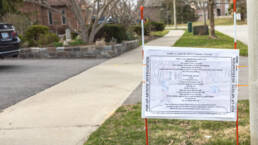
D. Tactical Urbanism Practice: Tactical urbanism has become a widespread technique for implementing interventions in urban areas in order to initiate civic engagement. In my practice, it offers me the necessary tools to install site-specific ‘sensory scores’ in public spaces for the purpose of engaging, directly or indirectly, everybody in the neighbourhood with art interventions. Belonging to the pop-up or temporary installation category, these playful interventions stay at the site for 48-72 hours before disappearing forever from our sight.
This ongoing interdisciplinary practice ‘ChoreoSensing’ has been developed through a practice-led artistic research program in the Netherlands and tested in multiple residential neighbourhoods of the Greater Toronto Area in 2022 and 2023. Its ultimate aim is to empower residents to (re)awaken their sensory engagement with public spaces within residential areas and subsequently, enhance their sense of belonging to the neighbourhood.
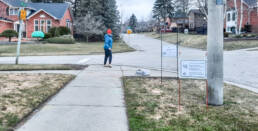
Sensory Scores
Below I share a set of selected ’Do-It-Yourself’ ‘sensory scores’ developed between September 2022 and May 2023. These allow users to see and hear the ordinary anew as they embody and sensorily engage with the natural, physical and social dimensions of everyday public spaces within their neighbourhoods.
Purpose: Here we are particularly interested in observing everyday social life as it unfolds in front of our eyes in public spaces.
Activity type – solo or group: Groups of 2-3 people are preferred for this activity is preferred for this activity.
Site: Neighbourhood public squares or neighbourhood open public spaces, which are seen as social junctions.
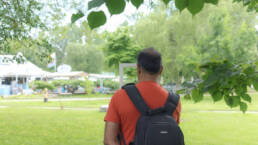
Materials Needed:
- A visual frame – could be made from wood, cardboard or even a simple piece of white paper. The recommended size of the frame is 8 inches X 10 inches.
- A wooden plaque, marker/chalk, and strings (optional)
Tasks:
Divide yourself into small groups of 2-3 members in each group.
Task # 1: (5 minutes)
- Choose a convenient location at the site. This location should allow you the opportunity to comfortably observe the social life unfolding at the site.
- Everyone stands at this location, observes the social activity, and discusses the experience with each other within their own group.
Task # 2: (5-7 minutes per observation point)
- Each group takes a visual frame. Members share the frame with each other within their own group.
- Each group chooses a spot at the site as its observation point. These spots should not be too close to one another. The groups then walk to their chosen spots.
- From the observation point, each group observes a particular side of the public space. No two groups should observe the same side of the public space.
- First, observe the side without the frame and then with the frame.
- When one member finishes the observation, the frame is passed on to the next member of the group.
- Each group member identifies social perspectives that interest him/her (with frame and without the frame) and shares the experience within the group.
- If there is only one group, please make sure you observe at least 3-4 sides of the public space.
Task # 3:(5-7 minutes)
- Based on the two tasks above, each group collectively creates at least two short descriptions of the site.
- These descriptions tell, in a few words, what new perspectives they have discovered. Group members can also collectively give names to this public space based on what they have observed and share them with the other groups.
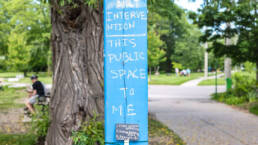
Task # 4: (5 minutes) (Optional)
- Each group writes the descriptions from Task # 3 on a wooden plaque using chalk/marker.
- Leave the plaques strategically at the site where they will be most visible. You can use strings to hang them from trees or poles or simply stick them on the ground.
You have just made a temporary art intervention in public spaces, and it expresses your voice!
Reflections:
- How did the activity help develop a sense of place for you in this public space?
- How did the visual frames affect your observations and experience?
- Let me know at #choreosensingpublicspace
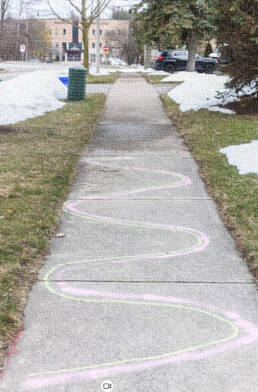
SCORE 2: Meandering Sidewalk
Purpose: Here we are particularly interested in exploring alternative visual perspectives of our everyday public space.
Activity type – solo or group: Solo activity.
Site: Sidewalks on your street or sidewalks within your neighbourhood that you regularly walk on.
Materials Needed:
- A camera. Your cell phone camera can work too.
Tasks:
Task # 1:
- Choose a small segment of the sidewalk for this activity. At your regular pace of walking, this segment should not take more than 3-5 minutes to travel.
- Stand at one end of the sidewalk.
- Start walking at your regular pace.
- When you reach the other end, turn around and walk back to the starting point at your regular pace.
- Now imagine the sidewalk is shaped like the body of a snake.
- Walk slowly on the body of this snake shaped sidewalk and observe what is in the immediate environment of it.
- Walk until you reach the other end of the snake-shape.
- Turn around and walk back the same way until you reach the starting point.
Task # 2:
- Repeat the steps from Task # 1.
- This time use a camera to photograph your visual observations as frequently as you want. For instance, during your regular walk, you take one photo (of your observation) every five steps you travel. Similarly, take one photo every five steps you travel during your meandering walk.
- Create a collage of the images taken during your regular walk.
- Create a second collage of the images taken of the same sidewalk during your meandering walk.
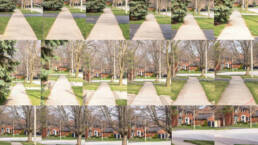
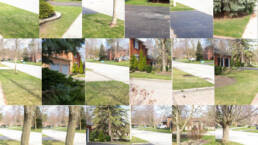
Reflections:
- What new visual perspectives did you discover of the sidewalk that you regularly walk on? Did they generate any new perception of this sidewalk in you?
- Let me know at #choreosensingpublicspace
Purpose: Here we are interested in listening to the soundscape of our street and becoming familiar with its acoustic characteristics.
Activity type – solo or group: Solo activity. But ask a friend or a family member to assist you if you do this activity blindfolded or with your eyes closed.
Site: On your own street.
Materials Needed:
- A sound recording device. You can also record through your cell phone.
Task (15-20 minutes per soundwalk)
- Start the soundwalk on your street. Walk slowly, listen deeply and mindfully to the soundscape of your street.
- If a sound catches your attention, pause, listen, and observe how you feel about that sound. The sources of the sound could be natural, physical, mechanical, or social.
- Record the sound using your recording device. Also, narrate your experience and record it.
- Repeat this soundwalk activity on your street at various times of the day – morning, afternoon, and evening. Spend 15-20 minutes during each soundwalk.
- Conduct this activity 3-4 days every season – Spring, Summer, Fall and Winter. These days should include both weekdays and weekends.
- Following every soundwalk, use your recording device to record your overall experience of the walk. During the recording mention the date and time of the recording.
Reflections:
- After every season, listen to the sound recordings you have made on your street. Is there a repetitive nature in your street’s soundscape? How does the soundscape vary between different times of the day, between weekdays and weekends and between seasons?
- What sounds are most dominant on your street and how do shape your experience of your street?
- What sounds are the least dominant on your street? If they were more present, how would they have helped you re-imagine your relationship with your street?
- Let me know at #choreosensingpublicspace
Purpose: Here we are interested in exploring how our public spaces are sonically shaped by the diversity of languages commonly found within Canadian residential neighbourhoods.
Activity type – solo or group: Solo activity.
Site: Neighbourhood public squares or neighbourhood open public spaces or neighbourhood public sports fields, which are seen as social junctions.
Task (as long as you like)
- Conduct soundwalks in the public social junctions within your neighbourhood during events – sports, cultural festivals, community gathering etc. During summer months these events are more common within neighbourhoods and many residents seem to take part in them.
- Walk close to the audience area, walk between people, and walk with people from an audible distance.
- Listen to the language they use for conversing among themselves.
Reflections:
- How many languages have you heard during your soundwalk?
- How would your relationship with your neighbourhood public space change if this sonic diversity disappears one day?
- Let me know at #choreosensingpublicspace
In conclusion, my hope as an artist-researcher in public spaces is that ChoreoSensing practice, through its performative scores and grassroots-level initiatives, will facilitate a more sensorily meaningful dialogue between Toronto’s residents and their everyday public spaces, a dialogue that instills active citizenship among residents but seems to have gradually disappeared in the run for creating ‘functional’ cities and communities in our contemporary time.
The ‘ChoreoSensing’ practice, and any materials developed within it, including, but not limited to, sensory scores, audio/video recordings, writings and images are copyright @2023 Mushtari Afroz. All rights reserved.
Ontario Culture Days runs an annual Creatives in Residence program. Part of the work of the Creatives is presented during public events for our festival of free arts and culture programming across Ontario.
Find more information on Mushtari Afroz’s project here, and read more about the 2023 Creatives in Residence cohort here.
